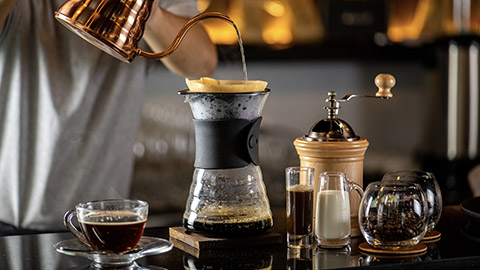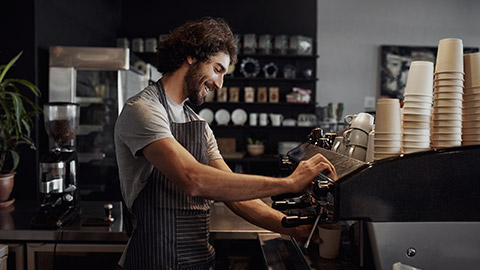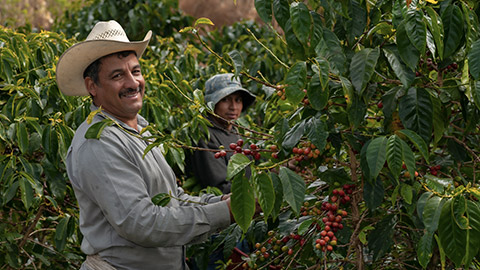Hi Allanis! Welcome to the Digital Learning Design practice task!
In this activity, you'll get the chance to demonstrate your skills in creating engaging learning content and using our Learning Management System (LMS) effectively.
You'll be given two tasks:
- H5P - building interactive H5P content and embedding it into the LMS
- Migration - transferring content from a provided storyboard into the LMS while following specific instructions and requests left by the storyboard author.
These tasks are designed to help you develop your proficiency in content creation, platform use and attention to detail. It will also help us identify areas for improving our Storyboard Templates, communication strategies and the overall migration process.
We encourage you to approach these tasks with creativity, precision, and a focus on enhancing the learning experience for students. Best of luck but most importantly, have fun!
The NCA Guide to Brewing Essentials
Coffee is personal - the right way to make it is how you like it best.
That being said, mastering a few fundamentals will help you perfect your technique. From here, we encourage you to experiment with different roasts, origins, or preparation methods.
Here are our tips to brew a classic cup of coffee:

The Equipment
Make sure that your tools — from bean grinders and filters to coffee makers— are thoroughly cleaned after each use.
Rinse with clear, hot water (or wipe down thoroughly), and dry with an absorbent towel. It’s important to check that no grounds have been left to collect and that there’s no build-up of coffee oil (caffeol), which can make future cups of coffee taste bitter and rancid.
Basic Maintenance
First, try to wipe down the outside of your machine daily to prevent residue build up – mornings get messy, and coffee is particularly prone to spills. You should also regularly clean any removable parts, which are generally dishwasher safe. However, always check the owner’s manual for specifics (…especially before disassembling your machine).
Major manufacturers recommend descaling your brewer at least every 3-6 months. In the meantime, you can prevent any potential problems with these additional tips:
- Use a fresh coffee pod each time you brew
- Choose filtered water rather than tap
- Change the water after each use
- Leave the lid off to allow the machine to air out
- Replace filter as needed
Descaling Your Machine
“Descaling” may sound intimidating, but it’s a simple process to sterilize and flush out the deposits that naturally build up over time – which can also leave a bad taste in your coffee. This step is especially important if you’re using hard water, which is one reason why filtered water is often recommended.
Depending on the machine, there can be an internal closed reservoir of water with a heating element. In these cases, you won’t be able to flush out the vinegar – resulting in permanently flavored coffee (and we don’t mean hazelnut). While this is more common with commercial machines, consumers using personal brewers have also reported this problem.
The Beans
Great coffee starts with great beans. The quality and flavor of your coffee is not only determined by your favorite brewing process, but also by the type of coffee you select. There can be a world of difference between roasts, so check out our roasting types guide.
Some of the flavor factors include:
- The country and region of origin
- The variety of bean - arabica, robusta - or a blend
- The roast type
- The texture of your grind
While there are a lot of choices, remember that there’s no right or wrong — for instance, you can choose a dark, flavorful espresso roast coffee and still have it ground to be brewed in a drip system. Have fun trying and enjoying different combinations.
Freshness
Purchase coffee as soon as possible after it’s roasted. Fresh-roasted coffee is essential to a quality cup, so buy your coffee in small amounts (ideally every one to two weeks). Check out our helpful tips on how to store coffee to keep it as fresh and flavorful as possible.
And please, never reuse your coffee grounds to make coffee. Once brewed, the desirable coffee flavors have been extracted and only the bitter ones are left. Instead, check out these six ways to recycle your old grounds.

The Grind
If you buy whole bean coffee, always grind your beans as close to the brew time as possible for maximum freshness. A burr or mill grinder is best because the coffee is ground to a consistent size.
A blade grinder is less preferable because some coffee will be ground more finely than the rest. If you normally grind your coffee at home with a blade grinder, try having it ground at the store with a burr grinder - you’ll be surprised at the difference!(Whichever option you use, always follow manufacturers' recommendations when using your grinder, and be mindful of any necessary safety considerations.)
The size of the grind is hugely important to the taste of your coffee. If your coffee tastes bitter, it may be over-extracted, or ground too fine. On the other hand, if your coffee tastes flat, it may be under-extracted, meaning your grind is too coarse.
If you're having the coffee ground to order, tell the professionals where you purchase your coffee exactly how you will be brewing it. Will you be using a French Press? A flat or cone drip filter? A gold mesh filter? They will grind it specifically for your preparation method.
The Water
The water you use is very important to the quality of your coffee. Use filtered or bottled water if your tap water is not good or has a strong odor or taste, such as chlorine.
If you’re using tap water, let it run a few seconds before filling your coffee pot, and be sure to use cold water. Avoid distilled or softened water.
Coffee-to-Water Ratio
A general guideline is called the "Golden Ratio" - one to two tablespoons of ground coffee for every six ounces of water. This can be adjusted to suit individual taste preferences.
Check the cup lines or indicators on your specific brewer to see how they actually measure. And remember that some water is lost to evaporation in certain brewing methods.
Water Temperature
Safety first! Of course, any time you are working with heat and hot beverages, take all necessary precautions for everyone from those preparing coffee, to those being served, and drinking coffee.
Your brewer should maintain a water temperature between 195 to 205 degrees Fahrenheit for optimal extraction. Colder water will result in flat, under-extracted coffee, while water that is too hot will also cause a loss of quality in the taste of the coffee. (However, cold brew does not need any heat.)
Coffee usually cools rapidly after being served, depending upon the container from which it is being served. And, many coffee drinkers may add cream or milk which also has a cooling effect. Ultimately, the temperature at which any individual coffee drinker will prefer their coffee is a personal preference, like so many other things that make coffee special. These are some of the reasons why it is best to serve coffee right after brewing, when it is fresh and hot. Cupping quality standards suggest brewing at 200˚F. When serving hot beverages, especially in retail or clinical care settings which present risks for burning or scalding, lower temperatures should be considered. Coffee drinkers often desire to add cold milk or cream, or just allow the hot beverage to cool to reach a comfortable temperature for drinking. One study has shown that coffee drinkers typically drink their coffee at 140 degrees Fahrenheit or below.
Brewing Time
The amount of time that the water is in contact with the coffee grounds is another important flavor factor.
In a drip system, the contact time should be approximately 5 minutes. If you are making your coffee using a French Press, the contact time should be 2-4 minutes. Espresso has an especially brief brew time — the coffee is in contact with the water for only 20-30 seconds. Cold brew, on the other hand, should steep overnight (about 12 hours).
If you’re not happy with the taste of the final product, you're likely either:
- Over-extracting:the brew time is too long
- Under-extracting:the brew time is too short
Experiment with the contact time until you get the right balance for your taste.
Enjoy your coffee!
Prepared coffee begins to lose its optimal taste moments after brewing, so only make as much coffee as you’ll drink. Otherwise, coffee can be poured into a warmed, insulated thermos to be consumed within an hour.
Try to enjoy your coffee as thoughtfully as it was prepared - take in the aroma, and notice the flavors in each sip. Many people have been instrumental in bringing it to your cup.
Activity 1.1

10 Steps From Seed to Cup
- Planting
Coffee seeds are generally planted in large beds in shaded nurseries. The seedlings will be watered frequently and shaded from bright sunlight until they are hearty enough to be permanently planted. Planting often takes place during the wet season, so that the soil remains moist while the roots become firmly established. - Harvesting the cherries
There is typically one major harvest a year. In countries like Colombia, where there are two flowerings annually, there is a main and secondary crop. In most countries, the crop is picked by hand in a labor-intensive and difficult process, though in places like Brazil where the landscape is relatively flat and the coffee fields immense, the process has been mechanized. Whether by hand or by machine, all coffee is harvested in one of two ways:- Stripped Picked
- Selectively Picked
- Processing cherries
- The Dry Method is the age-old method of processing coffee, and still used in many countries where water resources are limited. The freshly picked cherries are simply spread out on huge surfaces to dry in the sun. In order to prevent the cherries from spoiling, they are raked and turned throughout the day, then covered at night or during rain to prevent them from getting wet. Depending on the weather, this process might continue for several weeks for each batch of coffee until the moisture content of the cherries drops to 11%.
- The Wet Method removes the pulp from the coffee cherry after harvesting so the bean is dried with only the parchment skin left on. First, the freshly harvested cherries are passed through a pulping machine to separate the skin and pulp from the bean.
- Drying the beans
If the beans have been processed by the wet method, the pulped and fermented beans must now be dried to approximately 11% moisture to properly prepare them for storage.
These beans, still inside the parchment envelope (the endocarp), can be sun-dried by spreading them on drying tables or floors, where they are turned regularly, or they can be machine-dried in large tumblers. The dried beans are known as parchment coffee, and are warehoused in jute or sisal bags until they are readied for export. - Milling the beans
Hulling machinery removes the parchment layer (endocarp) from wet processed coffee. Hulling dry processed coffee refers to removing the entire dried husk — the exocarp, mesocarp and endocarp — of the dried cherries. - Exporting the beans
The milled beans, now referred to as green coffee, are loaded onto ships in either jute or sisal bags loaded in shipping containers, or bulk-shipped inside plastic-lined containers. - Tasting the coffee
Coffee is repeatedly tested for quality and taste. This process is referred to as cupping and usually takes place in a room specifically designed to facilitate the process. - Roasting the coffee
Roasting transforms green coffee into the aromatic brown beans that we purchase in our favorite stores or cafés. Most roasting machines maintain a temperature of about 550 degrees Fahrenheit. The beans are kept moving throughout the entire process to keep them from burning. - Grinding the coffee
The length of time the grounds will be in contact with water determines the ideal grade of grind Generally, the finer the grind, the more quickly the coffee should be prepared. That’s why coffee ground for an espresso machine is much finer than coffee brewed in a drip system. - Brewing the coffee
Activity 1.2

